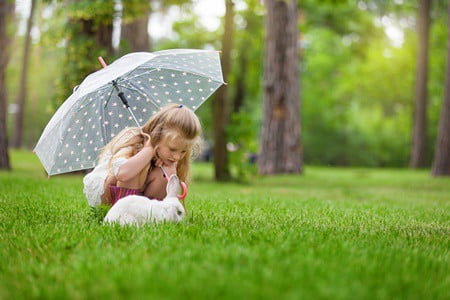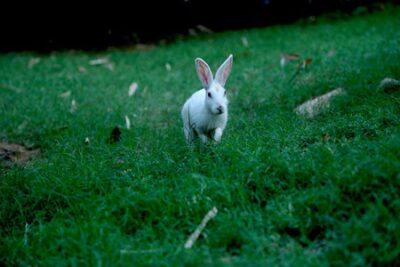Wild rabbits are outdoors throughout the year, even during the winter months. They endure rain, snow, and freezing cold temperatures. So, should you be concerned about your pet rabbit getting wet in the rain?
The main risk posed by a domestic rabbit getting wet during a rain shower is that it becomes too cold. This can result in hypothermia. In the wild, rabbits hide under any shelter they can find when it starts raining. If you have a healthy rabbit that has access to a shelter that’s dry and draught-free, you can let it play in the drizzling rain.
Young rabbits and rabbits with poor health (obesity, arthritis, etc.) should be kept out of the rain at all times. If your pet rabbit does get wet, bring it inside and dry it off thoroughly with a soft towel.
Can Rabbits Get Wet in the Rain?
Rabbits that are healthy and have access to warm and dry shelter, can be allowed to stay outside in the rain. Owners need to make sure that their pets’ hutches are weather-resistant and any damage is repaired routinely.
If your rabbit is old, young, or has a compromised immune system due to an illness, you shouldn’t let it play outside in the rain. Leaving rabbits outdoors in the rain with these risk factors increases their chances of suffering from life-threatening complications or sudden death.
How Rabbits Survive in The Rain
Rabbits are more resistant to the cold than they are to the extremely high temperatures of the summer. Rabbit fur has two properties that help them to stay warm in the cold and rain.
Water-Resistant
Rabbit fur has limited hydrophobic properties. So, their fur can repel water to a certain extent. This is similar to how rainwater doesn’t absorb into a leaf. Instead, it beads up and falls off. Rabbit fur shows a similar result.
Water is more likely to roll off rabbit fur, instead of being soaked into the hair. This prevents water from reaching a rabbit’s skin. The hydrophobic effect of rabbit fur helps rabbits stay dryer and warmer.

Provides Insulation
Rabbits also have specialized hair structures that protect them in the rain. In humans, hair is made up of the cuticle, the cortex, and the medulla. The medulla is the central column of the hair cells. In humans, the medulla is shapeless. In rabbits, the medulla is packed with air-filled cells.
This means that each hair on a rabbit’s fur consists of hollow columns that contain trapped air. The trapped air in a rabbit’s fur helps insulate it, keeping it warm in cold temperatures.
There is a limit to how much a rabbit’s fur and body can protect it from cold and rainy conditions. Rabbits try to avoid getting wet. In the wild, they’ll hide under logs or bushes to keep themselves protected.
When a rabbit’s coat gets wet, it reduces the insulating properties of its fur and body. This causes chilling, particularly in frigid winter conditions.
Why Rabbits Shouldn’t Get Wet
Chilling caused by wetness and cold weather, or windiness after getting wet, can induce stress in rabbits.
Stress has immunosuppressive qualities, especially in rabbits. With a weakened immune system, rabbits are highly susceptible to getting sick. Shock is another deadly result of chilling in rabbits.
Rabbits are at risk of hypothermia during cold, rainy conditions. Rabbits get cold quickly and it takes them a long time to dry themselves. Stress caused by hypothermia also makes rabbits likely to injure themselves. The rabbit may fight to free itself to find a warm shelter.
When they’re panicked, rabbits are capable of breaking their own spines. Rabbit skin is also very delicate and soft. Once it gets wet, it becomes softer, making it prone to tearing. This can lead to wounds that are difficult to manage, increasing the risk of infections.
Pneumonia
Pneumonia is caused by infections that inflame the lungs. It can be caused by bacteria, virus, or fungi. While small animals, such as rabbits are prone to pneumonia, rain does not cause it.
However, if rabbits are housed in cramped conditions, or if they’re unable to escape the cold and the rain, they may suffer from chronic stress. This can make them more prone to respiratory conditions, such as pneumonia.
Stress also makes rabbits vulnerable to respiratory infections, such as Pasteurella’s, also called snuffles.
Stress from Thunderstorms
Rabbits are highly sensitive to loud noises, such as those caused by thunderstorms. Loud and frightening situations can stimulate your rabbit’s adrenal glands to release epinephrine, increasing its blood pressure and heart rate.
According to the journal, Pathophysiology, arterial hypertension, high blood pressure, low blood pressure, and heart failure are common in rabbits and other animals sensitive to stress.
Stress caused by rain can also cause fright paralysis in rabbits. Fright paralysis is temporary and causes a rabbit to briefly become passive or appear dead. Research in Depression and Anxiety, states that this is a technique often used by prey animals to avoid being hunted.
Matting
Getting wet can also lead to frustrating and difficult-to-manage matting and knotting in rabbits.
Matted fur is unsightly for many owners. What’s worse is that it makes rabbits feel uncomfortable as well. Furthermore, severely matted fur can be difficult to get rid of in rabbits.
If matting does not improve with wiping, you may have to trim your pet’s fur, which can be stressful for both owner and rabbit. Avoid clipping matted fur as this may cut your rabbit’s skin unintentionally. Always remove knots regularly with a comb.
Rain-Proof Housing
If you keep your rabbits outdoors, make sure they are given adequate housing and bedding. During cold nights, there should be a tarpaulin or blanket over the hutch. Your rabbit’s housing should be dry, well-ventilated, draught-proof, waterproof, and dampproof.
Look for holes or gaps in the hutch on a regular basis and make necessary modifications and repairs. If you notice any rotting in the wood, apply a rabbit-safe wood protectant coating every few years.
Sloped rooves are preferable for rabbit hutches because they allow water to drain away. Keeping the hutch raised by 4 inches off the ground can prevent the bottom from getting wet.
Line the floors with extra hay, straw, and newspapers to allow your rabbits to bury themselves when they’re cold during the rain.
What To Do if Your Rabbit is Out in The Rain
If your rabbit isn’t able to find shelter or is surprised by the rain, check if it is alright. Rabbits have sensitive ears and aren’t able to shake off any water droplets that may enter them. Therefore, make sure your rabbit’s ear auricles don’t have any water to avoid otitis.
If your rabbit is very wet, take it inside, cover it with a blanket and dry it with a towel for a few minutes. This will help your rabbit feel safe, preventing stress and sickness. Avoid using a hairdryer as this can scare your rabbit.
If your rabbit’s chin or rear area is very wet or matted, talk to your vet immediately as these could be signs of an underlying health issue.
Anyone who owns a rabbit knows that rabbits prefer to live outdoors than indoors. However, to ensure your rabbit’s safety, it’s important to prevent it from becoming cold, wet, or miserable. As long as your rabbit is healthy and is able to find someplace warm and dry, you don’t have to worry about leaving it out in the rain.

